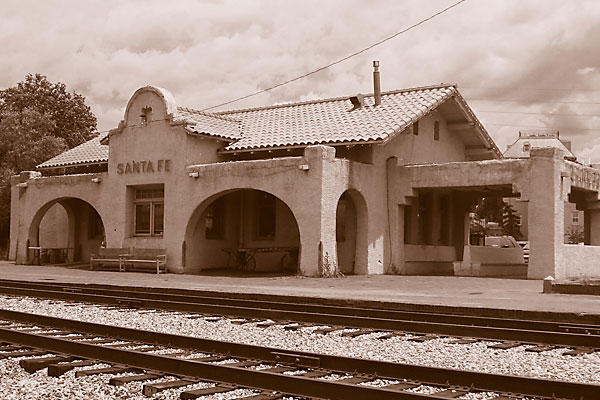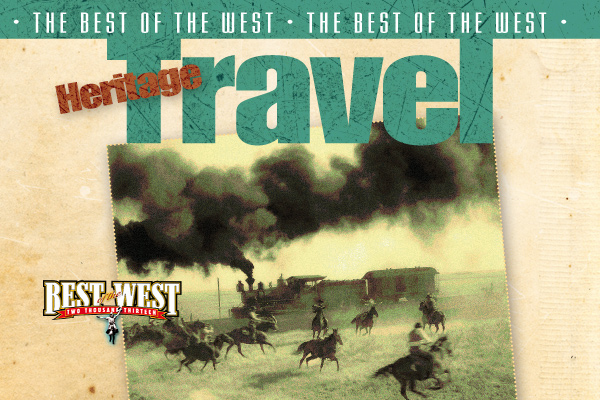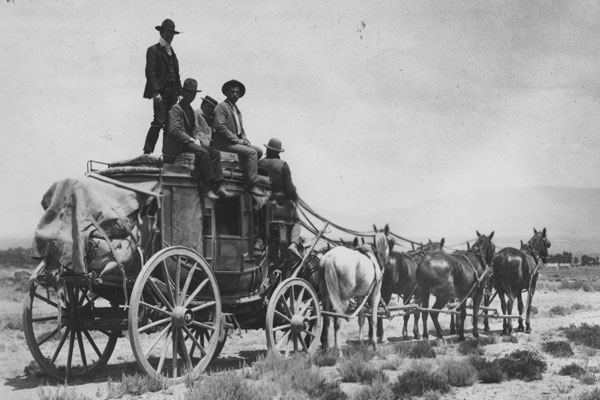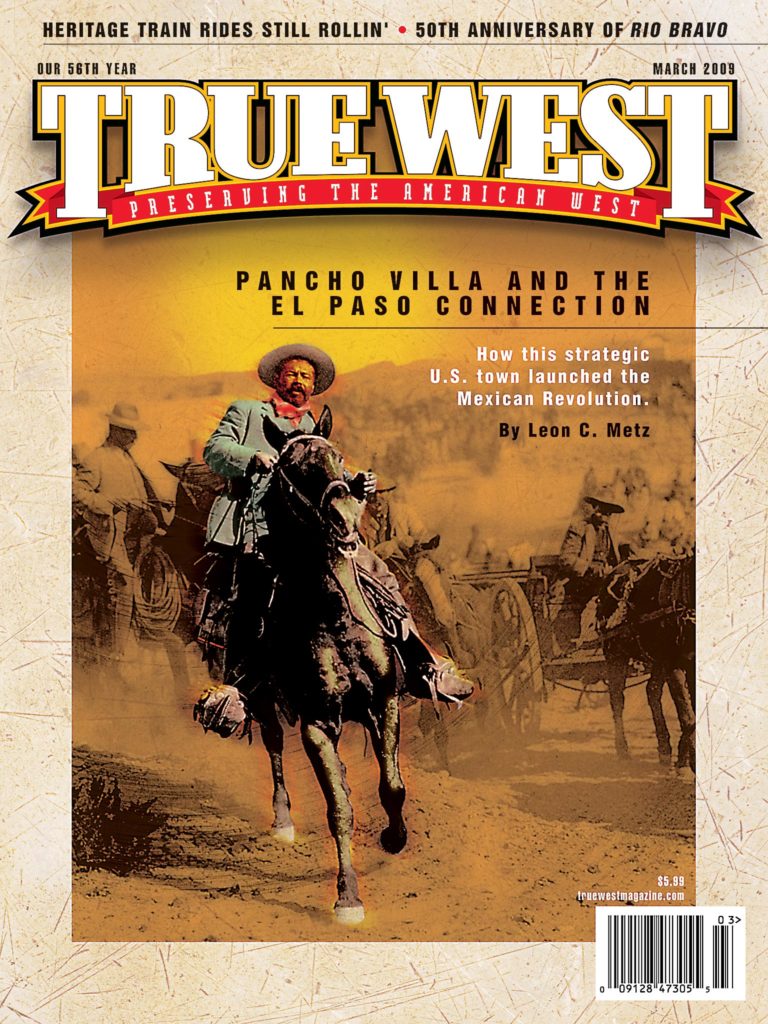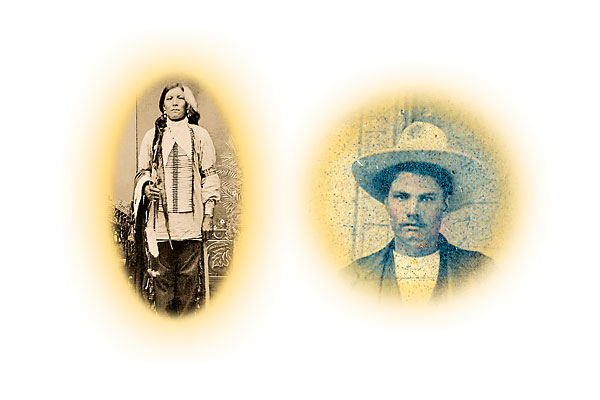
GENE AUTRY
If not for his job as a telegrapher at the St. Louis and San Francisco Railway, Gene Autry may not have become famous as the Singing Cowboy. By chance, he met Will Rogers in 1928, when he wired a newspaper column back East for the humorist. Autry often sang on the job, and Rogers, upon hearing the boy’s voice, suggested he try it professionally. Autry utilized a free railway pass to audition in New York City, but no one seemed interested in him. He returned to Oklahoma and started yodeling on recordings with his boss on the railroad, Jimmy Long. The following year, 1929, Autry signed with Columbia Records. His first hit with them came in 1932, “That Silver-Haired Daddy of Mine,” a duet he sang with Long. The rest, as they say, is history.
His music and life are celebrated today at the Gene Autry Days, held on June 27-28 in Kenton, Ohio, and the Gene Autry OK Museum Film & Music Festival, held each year on the weekend closest to Autry’s birthday (September 29). This year, the festival takes place on September 23-27, in Gene Autry, Oklahoma.
Kenton: 419-673-3131 HardinOhio.org;
Gene Autry: 580-294-3047 GeneAutryOKMuseum.com
WILL ROGERS
Speaking of the Cherokee-American cowboy humorist, Will Rogers, a look at his amazing life explains why he is remembered today. He was a gaucho in Argentina. A horse trainer in South Africa after the Boer War. A trick roper (most notably for Texas Jack’s Wild West Circus). A weekly columnist. A humorist giving lecture tours across the nation. A presidential nominee. A movie star at Fox Film (now 20th Century Fox) when talkies first came out. And the lead in Eugene O’Neill’s stage play, Ah, Wilderness!
That year, 1934, he declined to star in the movie version, freeing up his summer in 1935 to travel with Wiley Post. Post, a world-renowned aviator, and Rogers were about to embark on a flight during their trip around the world when the engine failed upon takeoff, killing both men. Oolagah, Oklahoma, honors the two in its annual event, Will Rogers—Wylie Post Fly In, taking place this August 16. Rogers was born in Indian Territory, near Oologah, and every year, his birthday is celebrated at Will Rogers Days in Claremore. This year’s celebration will take place on his birthday, November 4 (1879) and continues through the 7th.
918-341-0719
BUTCH CASSIDY
Horse theft landed the outlaw in the Wyoming State Penitentiary in Laramie, Wyoming. He was released in January 1896, and the town remembers him in its Butch Cassidy Days, held this year on June 27 – 28, put on by the territorial prison. In August of that year, he went back to robbing banks, with a successful heist in Montpelier, Idaho. The town celebrates its own Butch Cassidy Days on July 24-25.
Four years after his release from jail, Butch Cassidy and four other members of his Hole-in-the-Wall Gang reportedly robbed a train on the Union Pacific Railroad on August 29, 1900, near Tipton, Wyoming. This was Butch & Sundance’s last great train robbery as Butch Cassidy, the Sundance Kid and Etta Place later escaped into South America.
Laramie: 800-445-5303 • Laramie-Tourism.org;
Montpelier: 208-847-0067
BUFFALO BILL CODY
At age 12, he was a bullwhacker on a wagon train bound for Fort Laramie. The same year Annie Oakley was born, the 14 year old was hoping to strike it rich at the Pike’s Peak gold rush. By his 19th year, he was a Civil War hero. He was married and a father by the time he turned 20. Buffalo Bill Cody would eventually become the world’s most famous showman. He died shortly before his 71st birthday, and every year, you can commemorate his birth in North Platte, Nebraska. The Buffalo Bill Birthday Bash is held during NebraskalandDays on the Saturday closest to February 26 (1846). This year’s bash is held on February 28.
Buffalo Bill is also the inspiration for a celebration that raises funds for the restoration of the Sheridan Inn in Sheridan, Wyoming. The showman hosted auditions for his Wild West show from the front porch. The inn appears to be in good condition, but her foundation is actually poor and even the deterioration of the porch columns threatens the support of the building. This June 25-27, show your support for the restoration of the inn by attending Buffalo Bill Days.
Since 1912, Cody, whose famous Wild West show traveled the globe, has been honored by another exciting show: the Cody Stampede Rodeo in Cody, Wyoming. This year’s rodeo will be held on July 1-4. Cody is also home to the Buffalo Bill Art Show & Sale, held on September 25-26. This Western art sale benefits the prestigious Buffalo Bill Historical Center, which shares the accomplishments of this foremost communicator on the American West.
North Platte: 800-955-4528 • NebraskalandDays.com
Sheridan: 307-674-2178 • BuffaloBillDays.org
Cody: 800-207-0744 • CodyStampedeRodeo.com
888-598-8119 • BuffaloBillArtShow.com
CHARLIE M. RUSSELL
“To have talent is no credit to its owner; any man that can make a living doing what he likes is lucky, and I’m that. Any time I cash in now, Iwin.” Cowboy artist Charlie M. Russell wrote the above shortly before his death in 1926, yet the spirit of his Western vision is kept alive in the permanent collection at the C.M. Russell Museum in Great Falls, Montana. To help support the museum, contemporary and historical Western art will go on the block at the annual C.M. Russell Art Auction, which will be held this year on March 18-21.
800-803-3351 • CMRAuction.com
EDWARD SCHIEFFELIN
Working out of Camp Huachuca as an Indian scout, Ed Schieffelin still had not found his vein of riches. He had traveled to California in 1877 during the gold rush, and he was still prospecting near the San Pedro Valley at a plateau called Goose Flats. When he finally struck silver, he named his first mining claim Tombstone.
Today, the city he founded is one of the most well-known Old West locales. Its citizens rightfully pay tribute to him at Old West Founders Day Festival, held this year on April 3-5. In the past, people have been shuttled on excursion trips to the Schieffelin Monument from the Tombstone Courthouse State Historic Park.
888-457-3929
WYATT EARP
As much credit as Schieffelin deserves for finding the treasure that is Tombstone today, Wyatt Earp put the town on the map. You could almost call his participation at the Gunfight Behind the O.K. Corral, in October 1881, the “shot that was heard around the West.”
Wyatt, assisting his brother Virgil and aided by his brother Morgan and by Doc Holliday, claimed victory in the shoot-out. The nearly 30-second battle between the Cowboys and lawmen will be honored in mock gunfights put on by various re-enactment groups when Allen Street is shut down for Wyatt Earp Days on May 23-25. You can also catch a daily showing of the historic gunfight.
888-457-3929 • WyattEarpDays.com
CLANTON CLAN
Newman Haynes “Old Man” Clanton hired some of the toughest men to herd his cattle in the 1870s in southern Arizona, where cowboys and Apaches often clashed. His men were known as the “Cowboys.” The Cowboys forever went down in history when they clashed with the Earps and Doc Holliday at Tombstone’s most famous gunfight. Billy Clanton and Frank and Tom McLaury died in the shoot-out, while Ike Clanton and Billy Claiborne escaped with their lives.
For the past 15 years, Terry “Ike” Clanton has hosted a celebration honoring his ancestors, Clanton Days Rendezvous, which will be held this year on November 12-14.
888-457-3929 • ClantonGang.com
DALTON BROTHERS
Some of the Dalton brothers may have met their end in Coffeyville, Kansas, in 1892, but these former-lawmen-turned-outlaws are still remembered today for their outlandish attempt to rob Coffeyville’s two banks at the same time, with the plan to steal enough money to leave the country. Unfortunately for four gang members, all they left behind were their dead bodies.
Kansas hasn’t let their exploits die. The state commemorates the brothers in two events: Dalton Days Wild West Fest in Meade, home to a famous hideout of theirs, held on June 6-7, and Dalton Defenders Days in Coffeyville, where you can relive the raid on October 2-3.
Meade: 620-873-2359
Coffeyville: 800-626-3357
TOM MIX
Tom Mix had already appeared in several silent films when the mayor appointed him the first marshal in Dewey, Oklahoma, in 1912. The mayor was a friend of Mix’s in-laws, and the cowboy had been visiting their ranch while his wife gave birth to their daughter Ruth. Not yet a celebrity, Mix had appeared in movies filmed at the Miller Brothers’ 101 Ranch in Ponca City, where he worked as a wrangler. He would make it into the big time, like other cowboys who worked at the 101—Will Rogers, Ken Maynard, Tex Cooper and Bill Pickett. But Dewey hasn’t forgotten its marshal, and the town continues to celebrate him at the Tom Mix Festival and Wild West Show, held this year at the Tom Mix Museum on September 19-20.
918-534-1555
WILD BILL HICKOK
The faces of Honest Abe, Teddy Roosevelt, George Washington and the Sage of Monticello are carved into Mount Rushmore, which draws two million people annually. Some of those tourists will make their way to Deadwood, South Dakota, for Wild Bill Days on June 19-21. The murder of the famous gunfighter at Saloon #10—you can still throw back a drink and gamble at the rebuilt saloon today—made the poker hand he was supposedly holding, dubbed the “Dead Man’s Hand,” and Deadwood itself famous. The short-run HBO special celebrating the city’s heritage helped increase attendance in recent years, making this a big party featuring cowboy fast draw championships and re-enactments of historic Deadwood.
800-999-1876 • Deadwood.org
CRAZY HORSE
The Fetterman Massacre. The Wagon Box Fight. The Battle of the Little Bighorn. That last fight against the federal government, in June 1876, is what drew the most attention to this Lakota war leader. His role in the battle remains ambiguous to this day. Some historians think he was kicking back in his lodge, waiting for Custer and his 7th Cavalry. Others believe he was a major participant in the battle, possibly repelling the first attack led by Maj. Marcus Reno. Sioux fighter Little Soldier recalled, in 1936, “the greatest fighter in the whole battle was Crazy Horse.” Strangely, the event that honors this warrior has only one thing in common with him: horses. The Crazy Horse Stampede Rodeo, on the grounds of the Crazy Horse Memorial in South Dakota, will be held on June 19-21.
605-673-4681 • CrazyHorse.org
LEWIS & CLARK
On June 13, 1805, Meriwether Lewis was thrilled to see the Great Falls of the Missouri, a 900-foot wide and 80-foot high waterfall with a “beautiful rainbow” glistening above it. The waterfall was proof that he and fellow explorer William Clark had chosen the right fork in the Missouri River. They did not know four more falls gushed beyond it. What Lewis originally thought would be a mile portage turned into a 12-mile stretch, the hardest they had endured so far on their trip exploring the great American West under the auspices of President Thomas Jefferson. They finally made their way around the Great Falls more than a month later. The Lewis and Clark Festival honoring the adventurers takes place in Great Falls, Montana, on June 26-28.
406-452-5661 • LewisClarkIA.com
JOHN WESLEY HARDIN
This Texas badman met his match
in Constable John Selman at El Paso, Texas, in 1895. The funny thing was,
Hardin had reportedly hired Selman to kill the husband of a female client he was bedding. Supposedly, Selman shot Hardin because he never paid him for the deed. A hung jury dismissed Selman from paying for the crime, although he died a victim of a gunfight himself, in April 1896. Now their bodies rest for eternity in El Paso’s Concordia Cemetery. The August 19, 1895, gunfight that took the life of Hardin will be re-enacted by the Six Guns and Shady Ladies group at the John Wesley Hardin Secret Society Days on August 19.
915-842-8200 • ConcordiaCemetery.org
J.S. ACKER
James Samuel Acker was born in Shelby, Alabama, on August 6, 1865. By the early 1900s, he had found his way to Prescott, Arizona, where he ran a general store. He left town for a while, then returned in the 1930s to run a real estate company. Many of the parcels he bought were bequeathed to the city when Acker died on July 30, 1955. He wanted the land to be used for parks and music programs in Prescott.
Not until 1988, though, did Prescott resident LaVon Anderson come up with a way to honor Acker in historic Whiskey Row. She proposed the city put on a musical showcase in his name. Today, the J.S. Acker Musical Showcase is held every December (2009 date TBD). The holidays in Prescott are now synonymous with this pioneer lover of music; and the musicians who participate do so thanks to his generosity.
928-445-2000 • AckerShowcase.com
JESSE JAMES
Brad Pitt played him. So did Tyrone Power, Robert Wagner, James Keach and Rob Lowe. Robert Duvall, though, starred as the outlaw-turned-hero in one of the best Jesse James flicks of all-time: The Great Northfield, Minnesota Raid. Duvall’s Jesse kills and robs banks as payback for the Confederate loss in the nation’s great Civil War.
The end of the James-Younger Gang came when the townsfolk of Northfield armed themselves to help secure the bank; two of the robbers were killed, and everyone else ran for their lives. A gunfight would put a stop to the tracks of the Younger brothers and Charlie Pitts. Jesse and his brother Frank were the only ones who escaped. The September 7, 1876, gunfight will be re-enacted during Defeat of Jesse James Days, held in Northfield, Minnesota, on September 9-13.
800-658-2548 • DJJD.org
YOUNGER BROTHERS
With Northfield remembering the James boys, it makes sense that Madelia, Minnesota, puts on its Younger Brothers Capture, held near the site where the brothers — Bob, Cole and Jim — were captured and Charlie Pitts was killed. This year’s re-enactment takes place September 19. The re-enactment actually covers three events: the bank robbery, then the gunfight at Hanska Slough where Pitts was killed and finally the capture of the Younger Brothers, brought back to Madelia.
888-941-7283 • YoungerBrothersCapture.com
ZANE GREY
Zane Grey, the celebrated Western novelist, best known for his Riders of the Purple Sage, was also an avid fisherman. Mormon Lake, 30 minutes southeast of Flagstaff, Arizona, was his jumping off point for his adventures in the Rim Country. This June 15-18, the Zane Grey’s West Society is hosting its annual Zane Grey Convention there.
In Grey’s story of Joe Wetherill, a trader in Kayenta who discovered Nonnezoshe (known today as Rainbow Bridge, near Lake Powell), the author described Mormon Lake as “another snow-melted mud-hole, said to contain fish.” The protagonist of Tales of Lonely Trails doubted bass or perch could survive in it; perhaps catfish could. When it is a lake—as it’s fed from mountain snow melt and rain—you can fish for catfish, as well as trout and northern pike.
928-775-8960 • ZGWS.org
EVERETT RUESS
“I have not tired of the wilderness; rather I enjoy its beauty and the vagrant life I lead, more keenly all the time. I prefer the saddle to the streetcar and star-sprinkled sky to a roof, the obscure and difficult trail, leading into the unknown to any paved highway, and the deep peace of the wild to the discontent bred by cities.” This was the last word ever heard from the 20-year-old artist, sent in a letter to his brother, dated November 11, 1934.
A solitary individual, Everett Ruess nevertheless had endeared himself to painter Maynard Dixon and photographers Ansel Adams and Edward Weston. A sheepherder last saw Ruess near Davis Canyon in southeastern Utah. Today, Western art is celebrated in his name, at the Escalante Canyons Working Art Festival & Everett Ruess Days. This year’s festival will take place in Escalante, Utah, on September 25-26.
435-826-4199 • EverettRuessDays.org
GRAND DUKE ALEXIS
Who wouldn’t want to visit the buffalo hunting site of Gen. George Custer, Buffalo Bill Cody, Spotted Tail and the Grand Duke of Russia? Since 2000, the story has played itself out in Hayes Center, Nebraska, at the Grand Duke Alexis Rendezvous, held this year on September 25-27.
The hunt took place on the duke’s 22nd birthday in 1872, with the birthday boy astride Cody’s horse Buckskin Joe. The showman also loaned the Duke his famed buffalo rifle, Lucretia, and Alexis brought down his game with it. The next day, he learned the Indian way of hunting—bow and arrow—from Spotted Tail, and he killed two buffalo—but he used a pistol. General Custer and the Duke became the best of friends on this hunt, remaining so until Custer’s death four years later.
308-963-4369 GrandDukeAlexis.com
MAYNARD DIXON
In the 1930s, the dean of the business school at Utah’s Brigham Young University wired Maynard Dixon that he was heading to San Francisco to bargain for artwork, asking the artist to “soften his heart.” Dixon replied, “Heart soft in the center.” Today, the Brigham Young University owns the nation’s largest Dixon collection.
Dixon left San Francisco for his health, moving to Tucson, Arizona, and getting away from Arizona’s hot summers at his home in Mount Carmel, Utah, outside Zion National Park. But after six years, Dixon’s lungs couldn’t take Mount Carmel’s high altitude, and he and his wife left Utah forever in 1945.
Mount Carmel has never let the artist leave its heart. Maynard Dixon Country, an art show held at his historic home and studio, will take place on August 26-30.
The artist’s last commission was an assignment from the Santa Fe Railway. Attached to an oxygen tank, he painted the mural from his wheelchair. Less than a week after finishing the mural that would hang in the Los Angeles office, Dixon died, on November 13, 1946. The following year, his wife Edith scattered his ashes in Mount Carmel.
435-648-2653 • ThunderbirdFoundation.com


